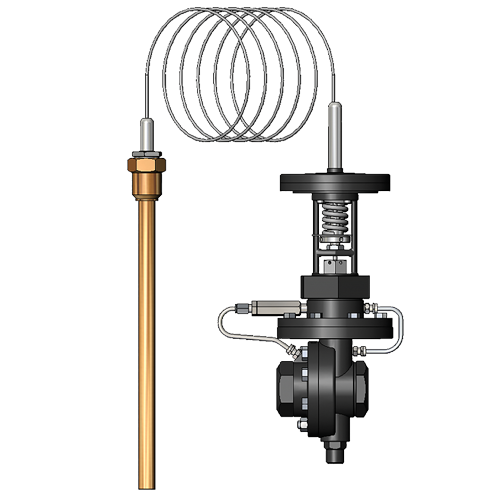Mark 82 Series
Internal Piloted Temperature Regulators | Direct or Reverse Acting | Sliding Gate with Sensing Bulb
Reverse Acting: The internal pilot valve seats and the main valve seats are up and closed. As the process temperature rises, the fluid in the sensing bulb vaporizes to apply pressure to the pilot diaphragm thus opening the pilot valve. The upstream pressure passes through the pilot valve, through the pilot port opening the main valve to provide the required cooling action.
As the temperature sensed at the bulb drops, the pilot valve tends to close, shutting off pressure to the main valve's diaphragm. The lower spring closes the main valve as the pressure on the main diaphragm is bled off through the downstream port.
Direct Acting: operated as above except that the pilot valve is normally open and closes on an increase in temperature.
All Jordan’s pilot-operated temperature regulators feature the sliding gate technology:
- Straight-thru flow for reduced turbulence, longer life and quieter operation
- Short stroke for fast response and accurate regulation
- Easily interchangeable Cv’s
- Extended tight shutoff due to wear resistant coatings and overlap of seat closure area
Sizes: 1/2″ – 2″ (DN15 – DN50)
Body Material: Ductile Iron, Bronze
End Connection: Threaded, Flanged
Cv (Kv): up to 30 (25,8)
Seat Material: Jorcote on SST
Control Range: 10°F (-12°C) to 325°F (163°C)
Sliding Gate Valves
You will notice something different in many Jordan valves … the sliding gate seat. A remarkably simple concept that offers superior performance and benefits not found in traditional rising stem and rotary valves.
CRN Number
Mark 82/82FS: 1/2″ – 2″
ATEX Certified
Your List
Email List
Get A Quote
Quick Quote
Know what you need and want a quote quickly? We can help! Fill out this form and we will get back to you shortly.


